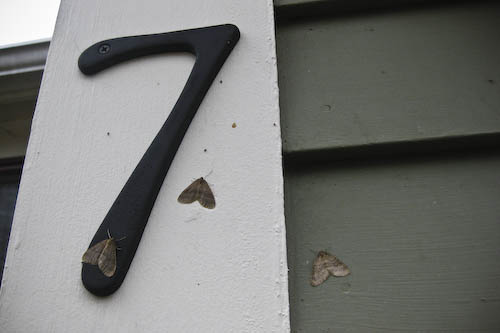Above: The return of these brown pests has prompted me to repost a story from three years ago. (Photo by Susan Fitzgerald)
A reader asked me a few questions, and this was one of them. “Why are there so many moths out now?”
I was shocked myself last week at how many were in our headlights as we drove down White Bagley Road. And I’ve been noticing them everywhere since.
But I was familiar with the pests from Susan’s past coverage on this blog. Apparently, the moths are an invasive species that first turned up in our area in the ’90s.
Below is Susan’s most recent writing on the moths, from December 2012. (Where links are outdated, I’ve provided new sources:)
In what has become an annual occurrence, the winter moths are back. I noticed the small brown moths for the first time several years ago, and have seen them every winter since. That’s not a good thing. The moths are harmless, but the eggs they lay turn into caterpillars that can do some serious damage.
For those of you new to the winter moth phenomenon, here’s some information I posted about the moths [in 2011].
We saw them in Southborough last year, too, but the winter moth is a relatively new pest in our area. They’re more common on the Cape and in eastern Mass, but they have been making a steady march westward. The moths start appearing around Thanksgiving, and can hang around into December and even January when the weather is mild like it has been this year.
The Massachusetts Introduced Pests Outreach Blog has an interesting write-up on the moths. According to that blog, the moths you see in flight are always males. Female winter moths are practically wingless and spend their days on tree trunks, house foundations, or other surfaces, waiting for a mate. While winter moths can be a nuisance when they cluster around homes in large numbers, they do their real damage as small green caterpillars, attacking cherry, crabapple and other trees in early spring and often completely defoliating them. [Editor’s Note: The link Susan had provided no longer works. But a new post on that blog includes information and a 2015 survey.]
[This web page] from UMass has some tips on limiting caterpillar damage in the spring, although from the sounds of it there isn’t a whole lot you can do. [Editor’s Note: The UMass website also has more background on the moths here.]
Have you noticed the moths around your house? Did you encounter any damage from the caterpillars last spring? What steps have you taken to control the buggers? Share your thoughts in the comments.
To look at the comments shared that year, click here. To share your experiences or knowledge, post a comment below.


